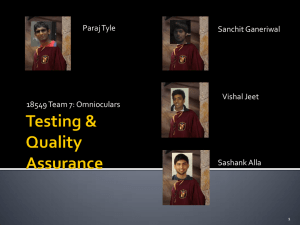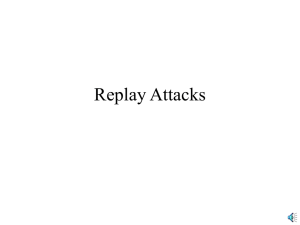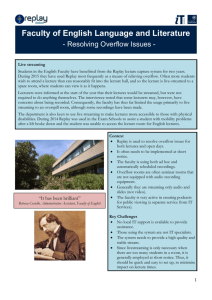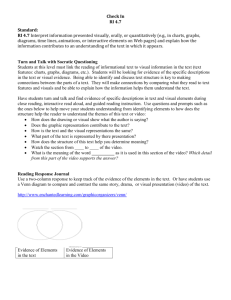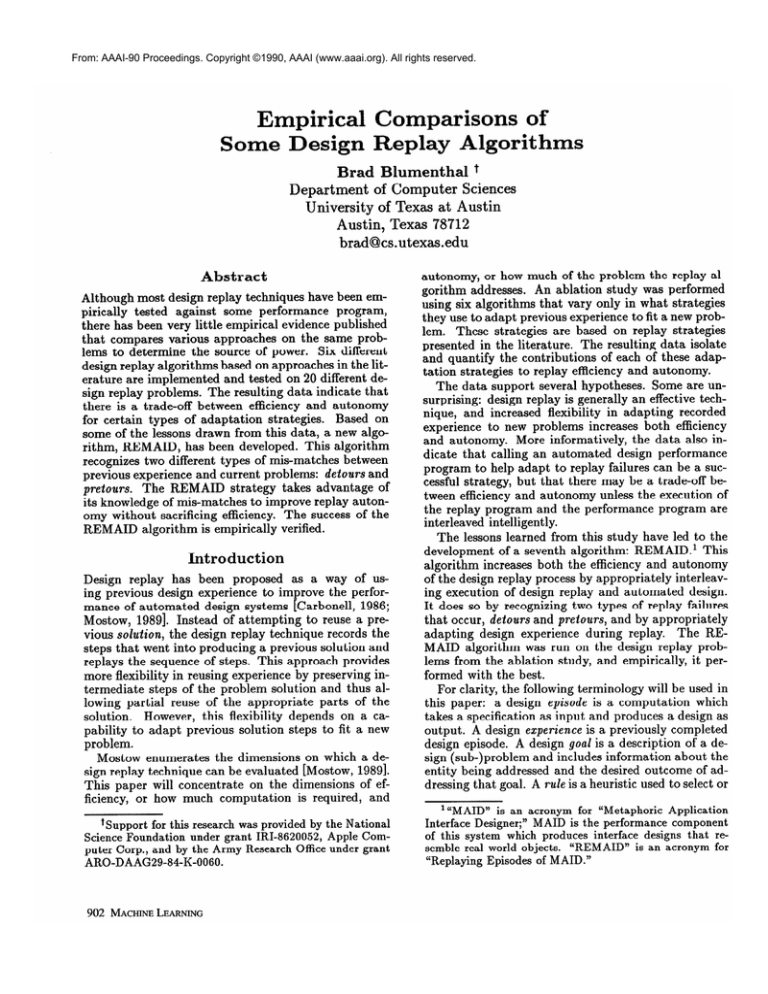
From: AAAI-90 Proceedings. Copyright ©1990, AAAI (www.aaai.org). All rights reserved.
Empirical
Some Design
Comparisons of
Replay Algorit
Brad Blumenthal t
Department of Computer Sciences
University of Texas at Austin
Austin, Texas 78712
brad@cs.utexas.edu
Abstract
Although most design replay techniques have been empirically tested against some performance
program,
there has been very little empirical evidence published
that compares various approaches on the same problems to determine the source of power. Six different
design replay algorithms based on approaches in the literature are implemented and tested on 20 different design replay problems. The resulting data indicate that
there is a trade-off between efficiency and autonomy
for certain types of adaptation
strategies.
Based on
some of the lessons drawn from this data, a new algorithm, REMAID,
has been developed. This algorithm
recognizes two different types of mis-matches between
previous experience and current problems: detours and
pretours.
The REMAID
strategy takes advantage of
its knowledge of m&matches
to improve replay autonomy without sacrificing efficiency. The success of the
REMAID algorithm is empirically verified.
Introduction
Design replay has been proposed
as a way of using previous design experience to improve the performance of automated design systems [Carbonell, 1986;
Mostow, 19891. Instead of attempting to reuse a previous solution, the design replay technique records the
steps that went into producing a previous solution and
replays the sequence of steps. This approach provides
more flexibility in reusing experience by preserving intermediate steps of the problem solution and thus allowing partial reuse of the appropriate
parts of the
solution.
However, this flexibility depends on a capability to adapt previous solution steps to fit a new
problem.
Mostow enumerates the dimensions on which a design replay technique can be evaluated [Mostow, 19891.
This paper will concentrate
on the dimensions of efficiency, or how much computation
is required, and
+Support for this research was provided by the National
Science Foundation under grant IRI-8620052, Apple Computer Corp., and by the Army Research Office under grant
ARO-DAAG29-84-K-0060.
902 MACHINE
LEARNING
autonomy, or how much of the problem the replay algorithm addresses. An ablation study was performed
using six algorithms that vary only in what strategies
they use to adapt previous experience to fit a new problem. These strategies are based on replay strategies
presented in the literature. The resulting data isolate
and quantify the contributions
of each of these adaptation strategies to replay efficiency and autonomy.
The data support several hypotheses. Some are unsurprising: design replay is generally an effective technique, and increased flexibility in adapting recorded
experience to new problems increases both efficiency
and autonomy.
More informatively,
the data also indicate that calling an automated design performance
program to help adapt to replay failures can be a successful strategy, but that there may be a trade-off between efficiency and autonomy unless the execution of
the replay program and the performance program are
interleaved intelligently.
The lessons learned from this study have led to the
development of a seventh algorithm: REMA1D.l
This
algorithm increases both the efficiency and autonomy
of the design replay process by appropriately interleaving execution of design replay and automated design.
It does so by recognizing two types of replay failures
that occur, detours and pretours, and by appropriately
adapting design experience during replay.
The REMAID algorithm was run on the design replay problems from the ablation study, and empirically, it performed with the best.
For clarity, the following terminology will be used in
this paper: a design episode is a computation
which
takes a specification as input and produces a design as
output. A design experience is a previously completed
design episode. A design goal is a description of a design (sub-)problem
and includes information about the
entity being addressed and the desired outcome of addressing that goal. A rule is a heuristic used to select or
“‘MAID”
is an acronym for “Metaphoric Application
Interface Designer;” MAID is the performance component
of this system which produces interface designs that reis an acronym for
semble real world objects. “REMAID”
“Replaying Episodes of MAID.”
address a design goal. A design history is a recording of
the goals and rules that make up a design experience.
“Step” is short for a recorded goal and its associated
rules and decisions. Thus, for the purposes of this paper, design replay is concerned with recording design
experience and using the resulting design history to
improve the efficiency and autonomy of a new design
episode. Typically this is done by matching a goal in
the history to a goal in the current episode, replaying
the corresponding
design rule, and continuing with the
next step.
The Domain
To test the various replay algorithms, a performance
program was written which automates the design of human interfaces for computer applications.
Thedomain
of automated human interface design is an especially
appropriate one because interface design is expensive
and time-consuming,
yet it is often desirable to have
multiple, alternate interface designs to a computer application.
Such a collection of designs might be used
to conduct user studies to determine what techniques
are most effective or to tailor computer applications
for specialized user communities.
The Performance Program
The performance
program used for this study is the
MAID interface designer. This program takes as input
a frame-based description of the objects and operations
that a computer program makes available to a user. It
produces as output a design for a human interface to
that application in terms of a set of interface techniques
such as menus, graphics, text, etc. In addition, the
MAID interface designer uses a knowledge base of realworld objects to produce metaphoric interfaces which
mimic the appearance
and behavior of such objects
[Blumenthal, 19901.
One of the most expensive operations in the MAID
program is choosing the next design goal to be addressed.
A characteristic
of the interface design domain is that there are default rules for addressing any
design goal. As a consequence,
MAID is not required
to do any backtracking ; however, in order to achieve
the best designs possible, MAID has to spend more
effort ordering the design goals.
Essentially, MAID
trades backtracking for extra goal-ordering
effort and
the possibility of sub-optimal
designs.
Therefore, at the heart of the MAID program is an
agenda of pending design goals. MAID uses a set of ordering- heuristics to select a goal from the agenda based
on the features of each goal, what other goals are on
the agenda, and the state of the design in progress. It
then uses a separate set of design heuristics to-address
the goal.
Applying design replay techniques to this problem
of selecting goals from the MAID agenda is promising
for the following reasons: since there is no backtracking in MAID, the order in which design subgoals are
addressed can significantly affect the resulting interface design; it is necessary to run the agenda ordering
heuristics at every step, since the relevant factors can
change in unpredictable
ways during the course of a
design; however, running all of the heuristics is expensive and only a small percentage of the heuristics tried
at any step usefully reduce the size of the conflict set.
The Experiment
The MAID design program is currently capable of designing five interfaces to a single application.2
Thus,
there are five possible design histories, each of which
can be used in the design of any of the five interfaces.
This gives a total of 25 possible design replay episodes,
including five trivial cases designing the same interface
in both the recorded experience and the new episode.
The six algorithms summarized below were implemented and run on all 25 cases. Data were collected
from the 20 non-trivial cases on the total number of
goals addressed, the number of goals replayed from
the recorded experience,
the total number of ordering heuristics which were applied to the agenda, and
the number of ordering heuristics that were useful in
selecting the next goal to be addressed.3
Current Techniques
Mostow outlines the important issues in successfully
applying the design replay technique,
including acquiring design experience, determining the correspondence between previously and newly encountered design goals, and determining the appropriateness
of a
previously executed design step in a new situation
[Mostow, 19891. This paper will focus solely on the
issue of adaptation:
the problem of reusing design experience when parts of a new design episode do not
match the previous experience.
There are two parts to this problem which Mostow
refers to as the adaptation
process.
This paper departs from that terminology slightly. The first part of
this problem, which is here referred to as “adaptation,”
is the question of what to do when a particular step
in a recorded history fails to match or address a corresponding goal in the current design episode. Strategies
for adaptation
vary from simply ignoring the failing
recorded goal to trying to modify the state of the current design episode so that the recorded step succeeds
in finding or addressing a corresponding
goal.
The second part is referred to as “recovery” and is
the question of what to do when none of the goals in
a recorded history can be successfully used to select a
2This is limited by the amount of knowledge entered in
the knowledge base, not by any inherent limitations of the
MAID program.
3Due to irrelevant technical details, accurate CPU times
were unavailable. All of the ordering heuristics use similar
amounts of CPU time, so for purposes of comparison, a
count of heuristic applications is adequate.
BLUMENTHAL
903
corresponding
goal from the current design state. Recovery strategies range from simply halting replay to
invoking a performance program and then attempting
to restart replay.
There have been a number of projects
addressing the problems in design replay since Carbonell’s
derivational analogy proposal [Carbonell, 19861. Three
projects that the REMAID
research builds on are the
BOGART/VEXED
project [Mostow, 19891, the work
by Carbonell and Veloso on using derivational analogy in the PRODIGY
system [Carbonell and Veloso,
19881, and the PRIAR project [Kambhampati,
1989a;
Kambhampati,
1989b].
The following
algorithms
vary only in their approaches to adaptation.
Since the domains used for
research in these techniques have varied from circuit
design to matrix manipulations
to blocks world planning it has not been possible to reimplement exact versions of the various algorithms for use in the interface
design domain. However, the approaches toward adaptation and recovery are domain-independent,
and they
have been preserved and implemented in order to determine how they affect the replay process.
Table 1 summarizes the six replay algorithms. There
are two adaptation strategies: simply skip the recorded
goal and try later or use alternate design rules. There
are three recovery strategies:
halt replay, use MAID
for one goal then restart replay, or use MAID for all
remaining goals. A short description of the research
motivating each adaptation and recovery strategy follows.
BOGART/VEXED
The replay program,
BOGART [Mostow, 19891, records design goals and the design rules for achieving those goals as they are chosen
by a designer who is using the VEXED circuit design
tool. BOGART
then applies the design rules in the
order in which they were recorded. BOGART
fails to
reuse a design rule if the corresponding
recorded goal
fails to match a goal in the current episode or if the
rule preconditions
are not satisfied by the matching
goal. The BOGART
approach to adaptation is to simply skip any design step that fails to be replayed. It
continues until it has tried every step remaining on the
history without success. BOGART’s
approach to recovery is to halt replay and ask the human designer for
a new history to replay.
HOBART4
implements the BOGART
approach to
adaptation and recovery. HOBART attempts to match
a goal from the history to a goal on the current agenda
of pending goals.
HOBART
simply skips any step
whose goal does not match a goal on the agenda or
whose design rule does not address the matching goal.
When no more goals on the history match any goals
on the agenda, HOBART
halts.
4The names of the reimplementations
for their phonemic similarity.
904 MACHINE
LEARNING
were chosen solely
PRODIGY
Extensions
Carbonell and Veloso’s extensions to the PRODIGY
system [Carbonell
and
Veloso, 19881 reuse a history that records the goal ordering decisions, variable bindings, and problem solving rule choices that produce a solution to a matrix
manipulation
problem, as well as the justifications
for
each of these decisions.
When PRODIGY
fails to reuse a recorded step, then
it follows what Carbonell
and Veloso call the “satisficing approach” to adaptation
and recovery.
One
strategy described for this approach is to address the
matched goal in some other fashion and then continue
replay at the next step. A second is to attempt to
satisfy the violated justification(s)
in some way and
continue replay at the current step.
There are a number of ways these strategies can be
implemented,
so one simple adaptation
strategy and
one simple recovery strategy were developed and added
to the basic HOBART algorithm, both separately and
together. The adaptation strategy is based on the first
satisficing strategy and is used when a recorded goal
from the history matches a goal on the current agenda,
but the recorded design rule does not apply. This strategy tries other design rules until one succeeds (recall
from section that there is always a default rule which
is guaranteed to succeed) and then continues replay at
the next step.
The recovery strategy is invoked when all of the goals
on the recorded history have been tried and none of
them match a goal on the current agenda. In this case
the MAID algorithm is invoked to select and address a
goal on the agenda, and replay is started again where
it was stopped. This is based on the second strategy;
something is done to satisfy the justifications
of some
recorded goal and replay is started where it left off.
The
implementation
of
HOBART
with the PRODIGY-inspired
adaptation strategy (alternate design rules) is called “PROBART.”
The implementation
which has the recovery strategy (select
and address one goal with a performance program) is
called “POSSIBLY.”
The implementation
with both
the adaptation strategy and the recovery strategy is
called “PROBABLY.”
PRIAR
Kambhampati’s
PRIAR
system
reuses
plans produced by a non-linear planner to solve new
planning problems [Kambhampati,
1989b]. PRIAR’s
adaptation strategy uses the pre- and post-conditions
of the recorded plan operations to determine what operations in the recorded plan to reuse. This strategy is
not feasible in the MAID domain5
PRIAR’s recovery strategy takes any goals that are
not satisfied by the old plan and posts them as new
goals that are then solved by the same non-linear plan5For one reason, the MAID domain has rules with conditional consequents. This prevents PRIAR from analyzing
the recorded rules to determine whether they will have the
desired effect.
1 Algortihm
11 Adaptation
Strategy
1 Recovery
Table 1: Summary of algorithms tested: strategy for adapting
recovering when recorded history can suggest no more goals.
ner that produced the recorded plan. This strategy
inspired a recovery strategy which use the MAID design program to address any goals left on the agenda
without attempting to restart replay. The first, called
“BRIAR,”
uses the HOBART
algorithm until replay
fails, and then invokes the MAID algorithm to address any left-over design goals. The second algorithm,
called “PYRE,” uses the PRODIGY-inspired
adaptation strategy (using alternate design rules) and the
PRIAR-inspired
recovery strategy (turn control over
to the performance program to finish the design).
Results
Table 2 presents the averages of the data collected from
20 different replay episodes of each algorithm.
The
data for MAID give the average number of goals addressed and the average number of heuristics tried and
used by the MAID performance program over five designs and is presented for comparison.
The efficiency of the various algorithms is measured
in terms of the number of applications
of ordering
heuristics that were needed to complete a design. All of
the ordering and match heuristics measured use similar
amounts of CPU time, so for purposes of comparison,
searching the agenda for a goal matching a recorded
goal on the history was counted as one heuristic application. Since all of the algorithms use ordering and
match heuristics for adaptation and recovery, this metric adequately captures the overhead due to replay.
The number of heuristics tried represents the number of heuristics which were applied (successfully
or
not) in an attempt to select a goal from the agenda.
The number of heuristics used represents the number
of heuristics which successfully reduced the size of the
conflict set (including those that actually chose a goal).
The autonomy of each algorithm was measured by
the number of goals that it successfully replayed. All
of the algorithms that used the MAID algorithm for
recovery completed all of the designs. HOBART
and
PROBART
halted when there were no more goals that
could be replayed.
Both the PRODIGY-inspired
adaptation
plan (expand one goal and restart replay) and the PRODIGYinspired recovery plan (try alternate design rules)
added similar amounts of autonomy. This is evidenced
by comparing the difference in goals replayed between
Strategy
II
to single recorded
rule failures,
and strategy
for
HOBART and PROBART
or POSSIBLY and PROBABLY (difference due to adaptation)
with that between HOBART
and POSSIBLY
or PROBART
and
PROBABLY
(difference due to recovery).
The PRODIGY-inspired
adaptation strategy of using alternate design rules also contributed to efficiency.
This is evidenced by the data for PROBART,
PROBABLY, and PYRE. Since checking the preconditions of
alternate design rules is very cheap compared to applying goal selection rules, the overhead for this approach
is nominal.
In terms of efficiency, the PRODIGY-inspired
recovery strategy was the most expensive, as seen by the
results for POSSIBLY and PROBABLY.
The most efficient performer is the PYRE algorithm which takes
advantage of flexible adaptation with a less expensive
recovery strategy. The least efficient is the POSSIBLY
algorithm which used the more rigid adaptation strategy and the most expensive recovery strategy.
Discussion
The foremost lesson of the empirical data is that, in
terms of efficiency, design replay is a successful approach. Although the implementations
employed very
simple adaptation and recovery strategies, all but one
of the algorithms required fewer ordering heuristics
than the MAID performance program. Even the simplest approach, HOBART,
replayed 43.4% of the design goals.
Autonomy
vs. Efficiency
Another important
point supported
by the empirical data is that using the performance
program for
recovery when the replay algorithm cannot find any
more corresponding
goals to replay is generally an effective strategy.
Although
this has been suggested
by Carbonell [Carbonell,
1986] and demonstrated
for
non-linear planners by Kambhampati
[Kambhampati,
1989a], the empirical data show that this is true if the
replay strategy is sufficiently flexible.
However, there seems to be a trade-off between the
amount of autonomy
afforded by using the performance program for recovery, and the cost of such a
strategy. The PRODIGYand PRIAR-inspired
recovery strategies represent two extremes. In general, more
BLUMENTHAL
905
Algorithm
Goals
Addressed
Goals
Replayed
Heuristics
Fried
Heuristics
Used
145.2
NA
1677.0
331.6
MAID
1 REMAID
11
145.2
Table 2: Results
1
of running
ill.7
Strategy
One conclusion that can be drawn from the trade-off
between recovery cost and recovery autonomy is that
some guide to navigating the history, other than linear search, is needed. One of the goals of the REMAID
project is to find a technique for intelligently interleaving design replay and automated design. Each of the
six algorithms compared above follows a strategy of aggressively pursuing only those agenda goals in the current episode that correspond to goals on the recorded
history. If a single step on the history fails to find or address a corresponding
goal on the agenda, it is ignored
and the next step is considered.
Recovery strategies
are only invoked when replayable goals on the history
are exhausted.
REMAID, on the other hand, attends to the kinds of
failures that occur and uses that information to modify the order in which the recorded history is used so
that it better matches the current agenda.
Thus, it
intelligently interleaves replay and automated design
and produces both an efficient and autonomous design
episode.
906 MACHINE
LEARNING
584.5
each algorithm
steps are reused when the history is examined every
time a goal is addressed. This is the case in the POSSIBLY and PROBABLY
algorithms.
The problem is
that it is very expensive to determine that more recovery is needed, and this usually must be done multiple
times.
The other extreme is to avoid the expense of recovery altogether by giving up on the replay algorithm
as soon as it can no longer suggest a goal to address.
This is the approach taken by the BRIAR and PYRE
algorithms.
Such an approach takes advantage of the
efficiency of design replay when corresponding
goals
are readily apparent, without spending any more effort on replay once the replay algorithm fails to find
a matching goal. This technique can tolerate a larger
number of goals in the new design episode that do not
correspond to goals in the recorded history; however,
it requires that most of the corresponding goals appear
on the agenda before the replay strategy is abandoned
and control is turned over to the performance program.
The REMAID
1
1
276.8
% Used/Tried
21.7
1
c
59.6
on 20 design replay problems.
The REMAID
Algorithm
The REMAID
algorithm reuses the experience of the
MAID automated interface design system. In addition
to each goal that was addressed, and the design rule
used to address it, REMAID records the heuristics that
usefully reduced the size of the conflict set when the
goal was selected.6
During replay, REMAID
applies the recorded ordering heuristics to the agenda and compares the resulting candidate goals with the chosen goal recorded
in the history.
If only one goal is chosen from the
agenda by the recorded ordering heuristics, and that
goal matches 7 the chosen goal recorded on the history, then REMAID
addresses that goal and continues replay with the next step recorded on the history.
The assumption here is that the same goal was chosen for the same reasons, and that replay is therefore
proceeding correctly.
REMAID
uses the PRODIGYinspired adaptation
strategy of considering alternate
design rules if the recorded design rule fails.
When the recorded ordering rules do not select a
matching goal on the agenda or when they select more
than one goal, REMAID
attempts to determine why
the recorded ordering rules have failed and attempts
to recover from such failures in a more appropriate
way than by just going to the next step in the linear
ordering of the design history.
Currently, REMAID
recognizes two classes of ordering rule failure: detours
and pretours.
Detours
If the recorded ordering rules choose more
than one goal, and one of the selected goals corresponds to the chosen goal recorded on the history, then
REMAID has encountered a situation where there are
new goals in the current design episode that were not
present in the design experience recorded in the history. Such a situation is called a detour.
REMAID
addresses the goal corresponding
to the chosen goal
6Recall from the discussion of MAID that the number
of useful heuristics is a small percentage of the number of
heuristics tried.
7REMAID
uses the same matching algorithm used by
the other six algorithms.
recorded on the history first. Any other goals are assumed to be new goals which are similar enough to the
chosen goal recorded on the history that they should
be addressed at the same time.
By recognizing detours, REMAID
can use its replay strategy on goals
that do not correspond
to any goal recorded on the
history. This strategy increases autonomy, thereby reducing the number of goals in the current episode that
have to be addressed with the performance program.
Pretours
If the recorded ordering heuristics choose
at least one goal, and none of the goals chosen match
the chosen goal recorded on the history, then REMAID
assumes that there are goals in the recorded history
that are not in the current design episode. Such a situation is called a pretour. If REMAID can find recorded
goals on the history that correspond to the goals chosen in this step, then it chooses the nearest goal in the
linear order of the history and continues replay there.
Instead of matching each goal on the history, one at a
time, against the agenda, REMAID effectively reorders
the history to better fit the current agenda.
If REMAID
cannot find any recorded goals on the
history to match the ones chosen, or if the ordering
heuristics recorded on the history for this step do not
choose any goals, then it calls on MAID to select a goal.
If the goal MAID selects corresponds to some goal on
the history, then REMAID
restarts replay with that
goal, again, effectively reordering the history. Otherwise, it continues to call MAID until MAID selects a
goal that corresponds to some goal on the history or
the design is complete.
By recognizing pretours, and using the performance
program to suggest where to restart replay, REMAID
can navigate through the history, intelligently interleaving the execution of the replay and performance
programs.
This strategy increases autonomy without
sacrificing efficiency.
REMAID
Results
The REMAID
algorithm was run on the same replay
problems given to the other six algorithms.
The averages for the 20 runs are presented in Table 2. Even
though REMAID
has more overhead for straightforward replay (i.e. replay with no pretours or detours),
it performed as autonomously
as PROBABLY
and as
efficiently as PYRE.
Conclusion
Most replay algorithms have been empirically tested
against some performance program, but very little empirical data have been published that compare various approaches in the same domain to establish the
source of power.
The data presented here indicate
that a flexible technique for adapting to single goal
n&-matches
increases both the efficiency and autonomy of replay. Further, using a performance program
for recovery from replay failures is a promising tech-
nique, but there is a trade-off between efficiency and
autonomy unless the replay algorithm can intelligently
interleave execution of the replay program and the performance program. Although efficiency and autonomy
are not the only ways that derivational analogy can
be evaluated, they do give a rough comparison of the
effectiveness of various approaches.
The REM AID algorithm recognizes the kinds of mismatches that occur during replay. By recognizing and
addressing detours, REMAID increases the autonomy
of design replay. By recognizing pretours, REMAID
increases autonomy and maintains efficiency by intelligently interleaving design replay and automated design.
Acknowledgements
I am grateful to Subbarao Kambhampati,
Ray Mooney,
Jack Mostow, Ken Murray, Bruce Porter, and Manuela
Veloso for comments, discussions and correspondence
on design replay and derivational analogy. I would also
like to thank Liane Acker, James Lester, and Penni
Sibun for comments on early drafts of this paper.
References
[Blumenthal, 19901 Brad
Blumenthal.
Replaying
Episodes of a Metaphoric
Application Interface Designer.
PhD thesis, University of Texas Artificial
Intelligence Lab, Austin, TX, Forthcoming 1990.
[Carbonell and Veloso, 1988] Jamie G. Carbonell and
Manuela Veloso.
Integrating problem solving and
derivational
analogy.
In Proceedings
of the First
Workshop on Case-Based Reasoning, 1988.
Derivational
[Carbonell, 19861 J amie G. Carbonell.
analogy:
A theory of reconstructive
problem solving. In R. S. Michalski, Jamie G. Carbonell,
and
T. M. Mitchell, editors, Machine Learning:
An Artificial Intelligence Approach, volume II, chapter 14.
Morgan Kaufman, Los Altos, CA, 1986.
[Kambhampati,
1989a]
Subbarao Kambhampati.
Control of refitting during
Joint
plan reuse. In Proceedings of the International
Conference
on Artificial Intelligence
1989, Detroit,
MI, 1989.
[Kambhampati,
1989b] Subbarao
Kambhampati. Flexible Reuse and Modification in Hierarchical
Planning:
A Validation Structure Based Approach.
PhD thesis, Computer Vision Laboratory, Center for
Automation
Research, University of Maryland, College Park, MD, 1989.
[Mostow, 19891 Jack Mostow.
Design by derivational
analogy:
Issues in the automated
replay of design
plans. Artificial Intelligence,
40( l-3), 1989.
BLUMENTHAL
907


